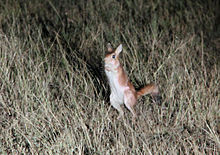East African springhare
| East African springhare | |
|---|---|

| |
| In Mbwea Safari Camp, Nakuru, Kenya | |
| Scientific classification | |
| Domain: | Eukaryota |
| Kingdom: | Animalia |
| Phylum: | Chordata |
| Class: | Mammalia |
| Order: | Rodentia |
| Family: | Pedetidae |
| Genus: | Pedetes |
| Species: | P. surdaster
|
| Binomial name | |
| Pedetes surdaster (Thomas, 1902)
| |

| |
| Synonyms | |
| |
The East African springhare (Pedetes surdaster) is an African mammal found in Kenya and Tanzania that is closely related to the South African springhare. It is a member of the Pedetidae, a rodent family, and resembles a small kangaroo.
Taxonomy
[edit]Pedetes surdaster was recognised by Matthee and Robinson in 1997 as a species distinct from the southern African springhare (P. capensis) based on genetic, morphological, and ethological differences.[3] P. capensis from South Africa has fewer chromosomes (2n= 38) than does P. surdaster which has (2n = 40) and some other genetic variations.[4] The species was confirmed by Dieterlen in 2005.[1]

Unlike South African springhare (Pedetes capensis), the second and third cervical vertebrae are fused in this species.
Distribution
[edit]This species is found in central and southern Kenya and most of Tanzania. A single specimen has been recorded in Uganda near the Kenya border, at Mount Moroto. It is found from sea level up to an altitude over 2,000 m.[1]
Description
[edit]
The East African springhare resembles a small kangaroo (a marsupial in the family Macropodidae of Oceania), and is about the size of a rabbit (Oryctolagus cuniculus). It is mid-brown, has large erect ears, very short forelegs, and long powerful hind legs.[5] It moves in bounds of up to 12 feet and has a long tail fringed with black hairs which provides balance.[6]
Ecology
[edit]The East African springhare is nocturnal and spends the day in an extensive system of burrows. It lives in semiarid grassland habitats.[1] The diet is the green parts of plants, roots and other vegetable matter, and occasionally insects.[5]
References
[edit]- ^ a b c d Butynski, T.M.; De Jong, Y (2016). "Pedetes surdaster". IUCN Red List of Threatened Species. 2016: e.T136621A115210504. Retrieved 22 December 2024.
- ^ Dieterlen, F. (2005). "Family Pedetidae". In Wilson, D.E.; Reeder, D.M (eds.). Mammal Species of the World: A Taxonomic and Geographic Reference (3rd ed.). Johns Hopkins University Press. p. 1535. ISBN 978-0-8018-8221-0. OCLC 62265494.
- ^ Matthee, C. A.; Robinson, T. J. (1997). "Mitochondrial DNA phylogeography and comparative cytogenetics of the springhare, Pedetes capensis (Mammalia: Rodentia)". Journal of Mammalian Evolution. 4: 53–73.
- ^ Matthee, C. A.; Robinson, T. J. (1997a). "Molecular phylogeny of the springhare, Pedetes capensis, based on mitochondrial DNA sequences". Molecular Biology and Evolution. 14 (1): 20–29.
- ^ a b "On Dipetalonema manson-bahri n.sp., from the Spring-hare, Pedetes surdaster larvalis, with a Note on its Development in Fleas". Journal of Helminthology. 35 (1–2). Cambridge University Press: 143–160. March 1961. doi:10.1017/S0022149X0002486X.
- ^ Butynski, Thomas M. (1984). Macdonald, D. (ed.). The Encyclopedia of Mammals. New York: Facts on File. pp. 634–635. ISBN 0-87196-871-1.

